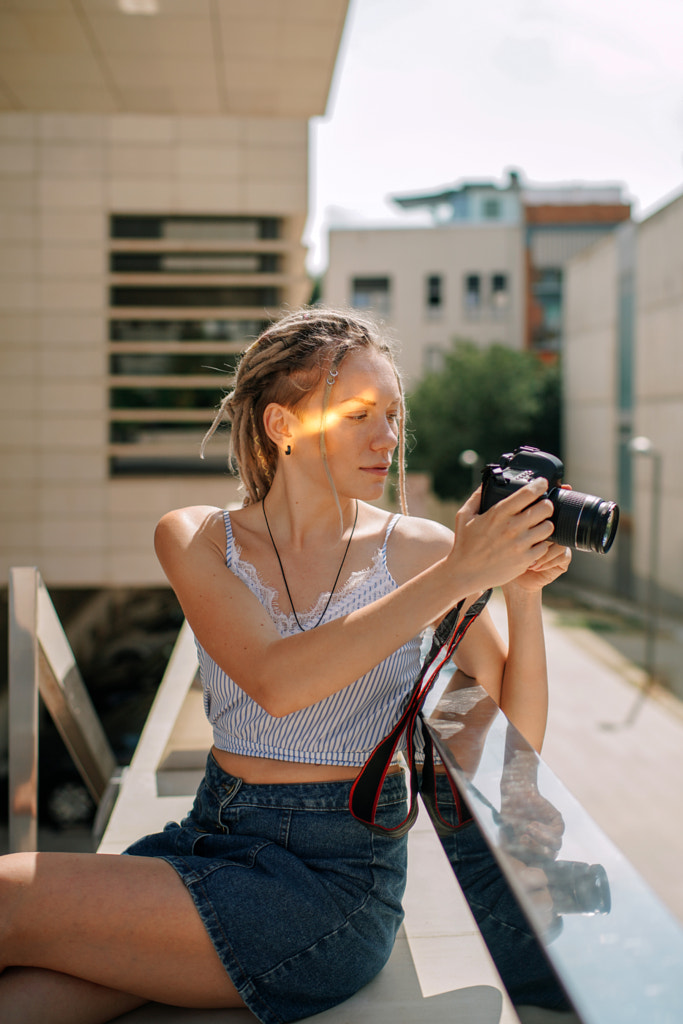Consider this: according to research from the Yale Center for Emotional Intelligence, artists experience more stress and anxiety when compared to those in other fields, but they also measure higher in terms of strengths such as hope or ego resilience—or the ability to recover from difficult times. In other words, artists might have more anxiety than people in other professions, but they might also be particularly skilled at navigating that stress and overcoming challenges.
For many of us, stress can be a daily challenge, even if we don’t talk about it. Freelance photographers wear many hats, seamlessly transitioning from the role of artist to businessperson to shoot director. Some nervousness is normal in a professional photography setting, and it’s something everyone in the industry faces at one point or another, regardless of their talent or experience. But it doesn’t have to be overwhelming. Here are a few simple tips for coping with those pre-shoot nerves.
Disclaimer: We are not, by any means, offering mental health advice, and we are not qualified to do so. This article is meant to address mild feelings of nervousness or “jitters” before a photoshoot—not anxiety disorders. If you find that anxiety is affecting your daily life, please reach out to a professional. You can start with the resources available through NAMI, the National Alliance on Mental Illness.
Do some practice runs
Test shoots are underrated but invaluable, whether you specialize in still life or portrait photography. Before a big shoot, see if you can do a test run, using similar tools, lighting, and styling that you plan to employ on the “day of.” It’s so important to connect and build relationships with stylists and other artists who are also building their portfolios; that way, you can set up times to collaborate and try new things to enhance both of your skill sets. Similarly, you can collaborate with models to implement ideas for lifestyle photography shoots.
In the long term, make sure you’re practicing consistently. Try shooting in all different lighting conditions so you’re ready for anything that comes your way. Regular test shoots are one way to get that practice in, and attending workshops (or online courses) is another. Finally, consider assisting other photographers. Assisting is a fantastic way to gain experience, build confidence, gather on-the-job photography tips, and learn skills that you can later implement when you’re running the show.
Get prepared
By making sure you’re prepared before your shoot, you can eliminate last-minute nerves. During pre-production and photo-shoot prep, make a list of all the props you plan to use and any gear you need to rent. Scout your locations to get a feel for any lighting challenges and equipment you might want to add to your kit. Make a plan for transportation and parking.
Visualize your shots, and develop a shot list to keep you focused. If you’re working with a team, share your reference photos and mood board and set some concrete goals together. Additionally, consider reliable backup models or assistants in case someone can’t make it on the day of the shoot.
As you get closer to the session, remember to clean and double-check your gear to make sure everything is working properly. Keep extras on hand as needed. A checklist of tasks to complete in the days before a shoot can help you stay on track. You can’t control everything (even in studio photography), but you can control a lot.
Another quick tip: always give yourself more time than you think you need, and arrive early. Rushing is never good for nerves.
Communicate openly
This tip falls under the “preparation” umbrella, but it’s worth mentioning again: keep the lines of communication open—with your clients, your assistants, your models, and so on. If you can, meet in person or over video chat. Going into the shoot knowing exactly what your client wants and expects will help settle those nerves, and sharing your thought process with your team will ensure everything remains cohesive.
Feel free to ask questions—does the client have a style guide, mood board, or reference images they’d like to share? What are some details you can give your stylist or makeup artist to make their jobs easier? Welcome questions from your team too. You want everyone to feel comfortable coming to you with potential problems so you can brainstorm solutions together.
Try journaling
Journaling can be a long-term outlet, providing space for you to check in with yourself, work through complicated feelings, set goals, and find solutions to problems. At the start of the pandemic, psychology researchers created The Pandemic Project, inviting people to write about the things that were bothering them: COVID, lockdowns, and so on. As they explained, you don’t need to devote more than five to ten minutes to putting your thoughts on paper (though you are welcome to do so). Spelling and grammar don’t matter, either.
Take a social media detox
Social media can be essential for photographers, whether you’re using it to find inspiration, gather creativity tips and ideas from other artists, or connect with clients. But it is possible to have too much of a good thing. Social media can spark feelings of FOMO (fear of missing out), comparisons between yourself and other artists, and worries that you aren’t good enough just because you don’t get enough “Likes.” Taking a step back, seeing your friends in real life, and doing activities that you enjoy—e.g., a trip to a gallery or a walk through the park—can help recenter and refocus your energy on what matters.
Breathe in; breathe out
In the moment, focusing on your breath can help calm those nerves. Find a comfortable, quiet place to sit, putting one hand over your belly. Breathe into your belly through your nose while counting to five, hold it for a count of two, and then exhale for a count of five. If you have a few minutes, you can also tune into a meditation app like Headspace or Calm for some guided exercises. If you’re in for a long day of shooting, remember to give yourself—and your team—some quick breaks throughout.
Get moving
This tip comes to us from the team at 500px. “Get up and move to ease your nerves. Feeling more comfortable in your own skin can directly translate to helping your subject feel confident.” If you find yourself “stuck” mid-shoot (mentally and physically), don’t panic; just try something else. Change up your angle, or get out from behind your camera and demonstrate how you’d like your model to move (showing is often better than telling). Let your models express themselves through movement too, and encourage them along the way.
Things can and do go wrong, whether you’re a commercial product photographer or a portrait photographer. But these things don’t have to derail your shoot. A good attitude fosters a productive working environment, so keep it positive and supportive. If you’re working with a team, consider setting the scene with music and snacks for everyone.
And finally, return to the basics
Another longer-term strategy is to regularly make time to remind yourself why you became a photographer in the first place. That could mean setting up an informal photoshoot with friends, or it could mean visiting a bookstore and browsing the photography and art sections. “Inspiration can come from unexpected places, from old vinyl record covers to a coffee table book,” the 500px team explains.
Outside of photography, nurture other creative pursuits and hobbies, whether that’s music or painting. Take yourself for a coffee date, and bring the old analog camera you used in school. Reread a favorite photobook, or look back on some of your most successful shoots. Your clients hired you for a reason: they like your work. Take that to heart, and use it as fuel for your creativity.
Parting thoughts
It’s important to recognize that you are not the first person to experience pre-shoot nervousness, and it’s okay to talk about these feelings! Pre-shoot anxiety is normal, but it doesn’t have to be all-consuming, so reach out to people who’ve been there and see if they have any coping strategies you can implement yourself. Prioritize your mental health. By staying prepared, opening the lines of communication, and checking in with yourself emotionally, you’re doing your part to stay calm and present on set. And ultimately, that’s when you’ll create your best work.
Not on 500px yet? Sign up here to explore more impactful photography.
The post Tips for photographers on how to tackle pre-shoot anxiety appeared first on 500px.








